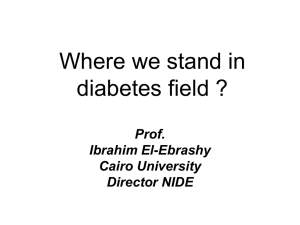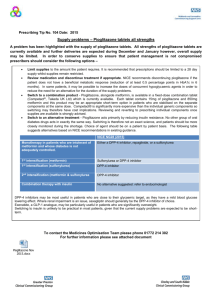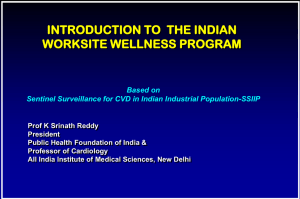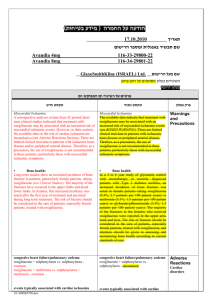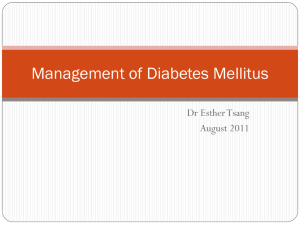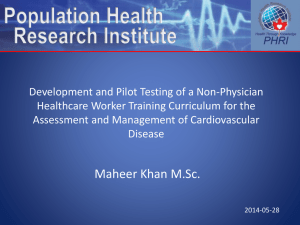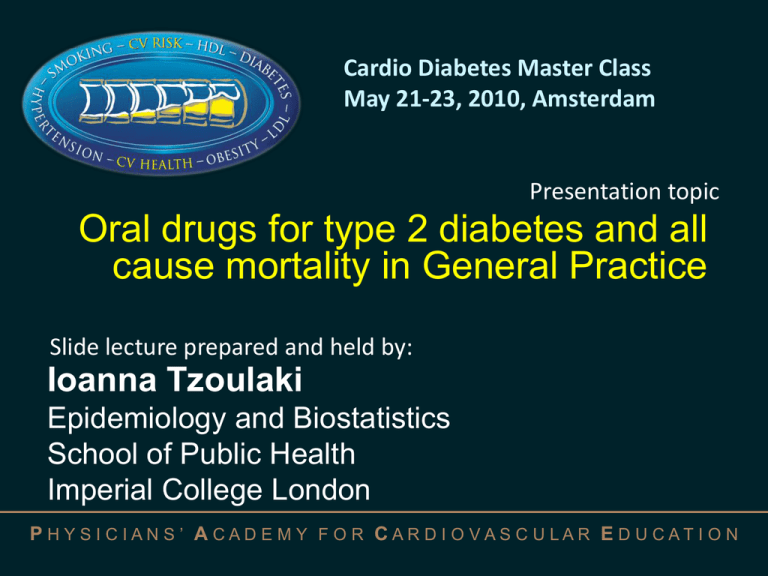
Cardio Diabetes Master Class
May 21-23, 2010, Amsterdam
Presentation topic
Oral drugs for type 2 diabetes and all
cause mortality in General Practice
Slide lecture prepared and held by:
Ioanna Tzoulaki
Epidemiology and Biostatistics
School of Public Health
Imperial College London
P H Y S I C IAN S ’ A CAD E M Y F O R CAR D I O VAS C U LAR E D U CAT I O N
Oral antidiabetes drugs
•Diabetes is considered a coronary heart disease equivalent in
adults older than 40 years
•Oral antidiabetes drugs for glycemic control
– recommendations based principally on evidence for reduced
microvascular risk
– concerns that some may increase the risk of cardiovascular events
Thiazolidinediones and IHD
•Initially approved as glucose lowering agents with a beneficial effect on
insulin sensitivity and a potential beneficial effect on risk of CVD
– Meta-analysis (Nissen et al 2007) of clinical trials showed increased risk of
ischemic heart disease
– Alternative meta-analysis techniques, new meta-analysis, new results from
RCTs, observational studies provided variable evidence
– RECORD and PROactive only RCTs to assess effect of rosiglitazone on CVD
outcomes
Thiazolidinediones and IHD risk based on RCTs (closed and
open squares) and their meta-analyses (closed and open
diamonds)
Kaul, S. et al. Circulation 2010;121:1868-1877
Pioglitazone
•PROactive and meta-analysis no increased risk on IHD
– Significant reduction in composite endpoints
•Observational studies mixed results
•Pio vs. rosiglitazone limited evidence for reduced IHD events for
pioglitazone from observational data
– No head to head comparisons in RCTs
Thiazolidinediones and HF
•Evidence for increased risk of HF for rosi and pioglitazone
– Meta-anaysis (Lago et al 2007), RECORD and PROActive
•No increased risk of CVD mortality
– Volume retention/ weight gain associated with thiazolidinedione
harmful?
Sulphonylureas
•University Group Diabetes Study: increased numbers of deaths from
cardiovascular disease among users of tolbutamide
•United Kingdom Prospective Diabetes Study: no increase in CVD or death
with sulphonylurea use compared with conventional diet group
•ADOPT: no difference in cardiovascular event rates between groups treated
with glibenclamide or metformin
•ADVANCE: intensive
therapy based on gliclazide reduced the risk of combined
macrovascular/microvascular endpoint (driven mostly by reduced
nephropathy) vs. less intensive therapy
– but had no significant effect on macrovascular events alone
The observational design
Limitations
–Bias/ Confounding by indication
–Differences in prognostic factors between different drug groups
• e.g. patients who had a greater risk of myocardial infarction were
preferentially given specific treatment
Advantages
–Clinically important but unexpected adverse effects of drugs are often
too rare to be detected in randomized trials
• Meta-analysis of RCT included trials with very few events
–Surveillance data through general practice are able to capture information
on drugs and events routinely on a wide range of patients as they present
for clinical care
Aims of this study
•To examine relative risk of MI, heart failure and all cause mortality among
different oral anti-diabetes drugs in a population study
Methods- GPRD
•The general practice research database (GPRD) comprises clinical and
prescribing data from anonymised patient based clinical records of about five
million people
•Obtained data on patients 35-90 between 1990 and 2005 and a diagnostic
code of diabetes
•Extracted data on prescriptions, MI, heart failure and all cause mortality,
cardiovascular risk factors
Methods- data analysis
•Interval of drug treatment as the unit of observation, defined as the period
from onset of a drug treatment to onset of the next drug treatment, or until
censored/ event
•2,843,007 intervals of oral antidiabetes treatments among 91,521 patients
with diabetes
•Periods when patients received insulin therapy, and events throughout
these periods were excluded
•Cox regression stratified by age at diagnosis and calendar year of
prescription
•Covariates were re-ascertained at each interval onset
Hazard ratios (HR) (95% CI) for first episode of myocardial infarction
among patients receiving rosiglitazone, pioglitazone, sulphonylureas
and other drugs and combinations compared with patients receiving
metformin monotherapy
Model 2 (N=2,761,889
intervals)
N
events
HR
Lower
95% CI
Upper
95% CI
P value
1st generation
sulphonylurea monotherapy
170
1.27
1.07
1.50
0.007
2nd generation
sulphonylurea monotherapy
1575
1.25
1.15
1.36
<0.000
1
23
0.97
0.64
1.48
0.902
83
1.06
0.84
1.33
0.610
24
0.78
0.52
1.17
0.224
Rosiglitazone monotherapy
Rosiglitazone combination
Pioglitazone monotherapy
and combination
Adjusted for age at prescription, year of prescription, sex, previous peripheral
arterial disease, previous CVD or HF, co-prescriptions of CVD drugs
Tzoulaki, I. et al. BMJ 2009;339:b4731
and any previous diabetes complications
Hazard ratios (HR) (95% CI) for first episode of heart failure among
patients receiving rosiglitazone, pioglitazone, sulphonylureas and other
drugs and combinations compared with patients receiving metformin
monotherapy
Model 2 (N=2,673,904
intervals)
N
events
HR
Lower
95% CI
Upper
95% CI
P value
1st generation
sulphonylurea monotherapy
520
1.29
1.17
1.44
<0.000
1
2nd generation
sulphonylurea monotherapy
3276
1.19
1.12
1.27
<0.000
1
38
1.07
0.77
1.48
0.688
125
1.27
1.06
1.53
0.011
48
1.10
0.83
1.47
0.512
Rosiglitazone monotherapy
Rosiglitazone combination
Pioglitazone monotherapy
and combination
Adjusted for age at prescription, year of prescription, sex, previous peripheral
arterial disease, previous CVD or HF, co-prescriptions of CVD drugs
Tzoulaki, I. et al. BMJ 2009;339:b4731
and any previous diabetes complications
Sensitivity analyses
•SUs subclasses: no differences
•Analysis truncated at 2000: no differences
•Analysis stratified for older than/ less than 65years: no differences
•
•No interactions between age, sex, aspirin or statin use and duration of
diabetes
•Model 3: adjustment for CVD risk factors, 60% reduction in sample size,
results need to be interpreted with caution
•Associations between thiazolodinediones and fracture risk significant
Summary & Conclusions
Differences in risk associated with different classes of oral
antidiabetes drugs
–Thiazolidinediones were not associated with risk of MI compared to metformin
–Thiazolidinediones were associated with higher HF risk compared to metformin
–Pioglitazone was associated with reduced all cause mortality compared with
metformin
–Pioglitazone had a favourable risk profile compared with rosiglitazone
•
•
requires replication in other studies
may have implications for prescribing within this class of drugs.
–First and second generation SUs were associated with higher risk of MI and HF
Findings favour metformin as the initial treatment for type 2 diabetes
–Thiazolidinediones increase the risk of heart failure and should not be initiated in
patients with class III/IV CHF
–Evidence for thiazolidinediones and CVD insufficient
–Insufficient data exist to support the choice of pioglitazone over rosiglitazone
–Further evidence for sulphonylureas and CVD is required


